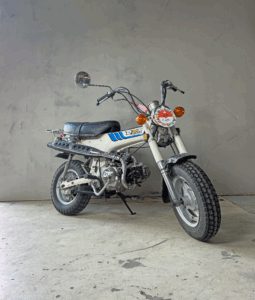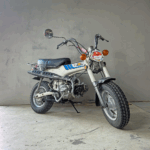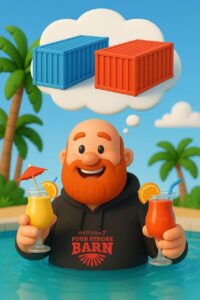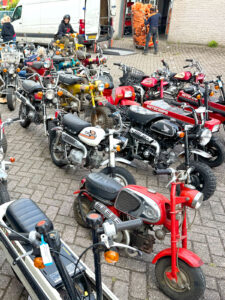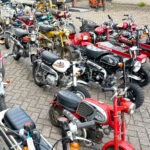The answer to frequently asked questions.
It’s nice to see that there is still a decent interest in the Honda C50 and other types of mopeds. Of course, a lot of interest also raises questions about the different types of Hondas can give in the different articles associated with this site. In this article we did everything we could to connect the pleasant (find out everything about the different Honda types) and the useful (sharing the knowledge gained with others).
You can read the results in the various articles and in this article we will go into the Honda C50. Read and enjoy and of course we are always up for constructive feed back. Please use our e-mail address FeedBack@fourstrokebarn.com. Of course, you can also use this e-mail address to ask questions about or provide input on the item.
If you are looking for workshop manuals or parts lists, you can download them for freevia this link.
The Honda Super Cub (C Series)
The Honda Super Cub, also known as C50/70/90 and many more, is a Honda moped/motorcycle with underlying frame. Its scooter-like appearance combined with the foot accelerations and driving characteristics of an engine make this a so-called scooterette. it came with the reclining four-stroke block with displacements from 50cc to up to 125cc in the most modern interpretations.
Production started in 1958 and in 2008 the production number exceeded 60 million. That’s more than the Volkswagen Beetle, Mini and 2CV combined. it holds the world record for most produced motor vehicle.
Development
When Soichiro Honda and an associate of his, Takeo Fujisawa– who it through Germany in 1956 – experienced how popular mopeds and light motorcycles were there. Soichiro Honda was the technical and production manager of the small Japanese motorcycle company “Honda”. it wanted to be progressive in engineering and have success in motorcycle racing. His collaborator and close friend Takeo Fujisawa was more of the economy and trade. Fujisawa’s goal was to sell a lot with sophisticated trading strategies, dominate any market and wipe out the competition. it was thinking about the best way to expand the company as soon as possible and, on the contrary to many other Japanese engine builders, did not want to do so alone by taking advantage of japan’s recent economic growth. A small fast motorcycle should take care of this. Most European consumers started with a regular bike, then one with a detachable engine, then a scooter, then a very small car and so on. Fujisawa noticed that a motorcycle was not part of this pattern and his plan was to make sure that would be the case. Soichiro Honda, meanwhile, got a little tired of Fujisawa’s idea. Honda came to Europe to win the Isle of Man TT motorcycle races.
Together Fujisawa and Honda visited several Kreidler and Lambretta dealers to further develop the idea of the small fast engine. Fujisawa said the models they saw in Germany had no future and would not sell properly. His idea was a bike for everyone: for developed and developing countries, for the city, but also for the countryside. The motorcycle should have simple technique, so that even people who don’t know about it and don’t have good tools can keep it moving. it didn’t have to be too noisy, but he had to be reliable, especially the electronics. As Honda’s business grew faster and faster, it needed a product that attracted a lot of people and can be produced on a very large scale. The design should be completely perfect in advance, as it would be too costly to repair it afterwards. A scooter came very close, but was too complicated for the developing countries and the small wheels did not ride pleasantly on bad roads. Another requirement of Fujisawa was that one could ride the motorcycle with one hand, so that you can wear noodles in the other hand. it told Honda: “If you can design a small 50cc motorcycle with all the electronics and hoses neatly hidden, I’ll sell it. I don’t know how many noodle pick-ups there are in Japan, but I’m sure they’d all want one to deliver the noodles.””
When Honda became interested in Fujisawa’s ideas, it began to develop the Super Cub as soon as it returned to Japan. In the following year, Honda showed its concept to Fujisawa, which exactly matched Fujisawa’s wishes. it estimated they could sell about 30,000 a month of it. That’s about half of total monthly motorcycle sales across Japan. The intention was to eventually sell motorcycles worldwide on a scale larger that was unheard of in post-war Japan. While most Japanese companies had their foreign sales handled by foreign companies, Honda was convinced that its own trading network abroad would be more successful, especially in large countries such as America, Germany and England. From this came the American Honda Motor Company in 1959. In 1961 dealers arrived in Germany and soon after Belgium, France and the Netherlands followed.
A scooter honda offered at the time was the Honda Juno. The Juno was the first scooter to have a plastic and fiberglass bodywork. However, production of the Juno had already stopped in 1954, because Honda was in financial trouble at the time. Yet Fujisawa believed in the use of plastic in a motorcycle or scooter. This laid the foundation for the Super Cub, from which the leg screen would be made of plastic. Honda had to make it itself, because the supplier of the plastic itself would not be able to make enough. Motorcycle historian Clement Salvadori once wrote that the plastic leggings were the cub’s biggest advantage. They were much cheaper than metal ones and worked at least as well. Such a thing now seems very logical, but it used to be quite innovative and special. Honda’s technological knowledge in the Isle of Man TT motorcycle races also came in handy in the development of the motorcycle. A 50cc four-stroke engine could now deliver about 4.5 hp. That was quite an achievement: four-stroke engines with three times as much displacement were usually less powerful.
To make the new motorcycle in large numbers, Honda built a new factory big enough to build thirty to fifty thousand motorcycles a year. Secretly, the factory was a bit tired of the Volkswagen production line in Wolfsburg. Before then, only two to three thousand copies of the best-selling Hondas were sold per month. Edward Turner of engine manufacturer BSA came to take a look at Japan and said investments like this were “very dangerous.” This was mainly because in large countries in America motorcycles had acquired quite a bad image. The new factory, which was by the way called Suzuka, was the largest engine factory in the world and became a base for all future Honda factories. When the plant was running at full speed, it collected about 18% of the cost of production. In the short term, that alone did not work, because the sales network was not yet fully started.
Design
The different C-types all had a frame of printed sheet metal that consisted of one piece. The horizontal engineyou were under the middle part of the frame. A shape like that of the C is often called a “step-through” or child frame. Because it is difficult to place as a motorcycle or scooter, it is often called scooterette.
A plastic leg protector ran from just under the Handlebar to under the footrests. For example, the rider was protected from wind and loose material on the road. As a bonus, the engine was also neatly hidden, which made the Super Cub look elegant. This design was a bit like that of a scooter, but here the engine was not attached to the rear axle. This configuration had a few advantages: it provided a Bearing center of gravity, less approximately weight and it gave better cooling. Larger wheels could now also be used. The settling tank was under the foldable Seat 17-inch wheels made for a more pleasant handling than the 10 inches, which were often under scooters, and gave a more attractive appearance.
The stuttering block that was under the first C’s was a four-stroke single-cylinder in reclining configuration, like most Honda mopeds and light motorcycles. it had a 40mm bore and a 39mm blow. That brought the cylinder capacity to 49cc. Some 4.5 hp at 9500 rpm were delivered and under favorable conditions the top speed was about 69km/h. A low compression ensured that the block could also run well on petrol with a low octane content and that it was easy to kickstart. Still, some models did have an electric start, but most didn’t. Even the new c50 and 110cc variants are still available in some places with only a kickstarter.
The C’s gears were foot switched, but there was no clutch. This worked by means of a centrifugal coupling and a system that automatically disconnected when switching. Although smooth shifting with this gearbox requires some practice, it is easy to learn the basics. New riders were not deterred by having to learn to pair. You could also start a Super Cub by pushing it. This couldn’t be done with scooters.
In the beginning, the C-tjes had 6 volts of point ignition. This means that the ignition time is mechanically determined by a set of Breaker contact that react to the magnetic field of the flywheel. Later versions had a 12 volt electronics with a computerHandlebarthe ignition. In the former stutter rod models, the lubrication was done by spinning wheel that hurled oil around. In the versions with overhead camshaft, an oil pump was used. Both front and rear had the small Honda drum brakes. Some modern motorcycles derived from the C, such as the Honda Wave and Innova, do have a scitfrem on the front.
Honda recommended checking the horn, tire pressure, brakes and oil level every day. The liquid level of the battery should be checked weekly. An engine had driven in after 320km. One then had to adjust the valve clearance and the Breaker contact and change the oil. Ideal was to stay the first 800km below 48 km/h. Every 1000km the spark plug had to be cleaned and every 3200km the oil has to be change, the points adjusted and valve valves set. Before its time, the Super Cub was relatively maintenance-friendly and reliable.
Current poplarity
The different C-variants can still be found relatively well in the Netherlands, despite the fact that they have not been delivered here since the 1970s. Many specimens are quite worn and rusty, but both can be easily repaired. A good one is getting more and more expensive. Most C-riders are people who have had one in their youth and people who think it’s a nice model, want something special or like it.
In Asia, the supercub is still big. It remains a cheap and fast way of transport, because a car there is too expensive for most. With modifications such as fuel injection, it also meets the environmental requirements in most countries.
The different models
Many different models of the C have been produced. Here will be some mentioned and explained. Some models may not be mentioned, because there are a lot of variants Super Cub and there are only very small differences between some. Moreover, it is difficult to find which models are all produced and what their specifications are. Most old variants will be discussed. Some modern variations too. Sporty versions of the Cub with a frame in other style, such as the C110 or C320, don’t. There are also many different versions of the C50/70/90. These will be given a more detailed explanation in a different article.

C100 Super Cub (1958)
The model that started it all. Had a 50cc stutter rod motor and special pointed indicators The headlight was not yet built into Handlebarbut into the Front Fork A version with electric start came in 1959. It was called C102 and was built for the American market. The C100 has been sold almost all over the world, including in the Netherlands. it was not yet homologated as a moped and thus came on motorcycleregistration . Now it is possible to put a C100 on mopedregistration

C100T/C105T/CT200 Trail Cub
An off-road version of the C, intended for the American market. Came first with 50cc (C100T), then 55cc (C105T) and also with 90cc (CT200). All with stutter tongs. Was actually a stripped C100 with two rear gears so you have high and low gearing. With the first versions, a front fender was even an option. Later it became standard.
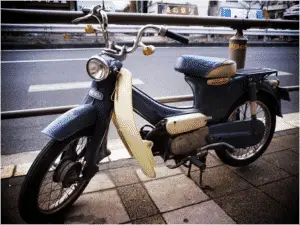
C240 Port Cub (1961)
Very rare variant of the C. Was only sold for a short time only in Japan. Looked like a C100, but had a different frame and was a bit more spartan. The kickstarter was on the “wrong” side. The engine was 50cc and was slightly different from the C100.

C310 -1963
A moped specially developed for the Dutch and Belgian market. The C310 was built in Aalst, Belgium. Trappers ensured it can now be classified as a moped. The Dutch version also needed a white piece on the rear fender for this. The C310 was considered very special, because it was one of the first four branches in the Netherlands. Its 3-hand gearbox with a clutch that automatically disconnects when driving away makes It it to prepare. Early C310s were of the so-called “a” type and had an engine based on the Port Cub. The later version was called C310S. Its engine was derived from the C100. Belgian versions of the C310 had a faster engine
C65 Super Cub (1965)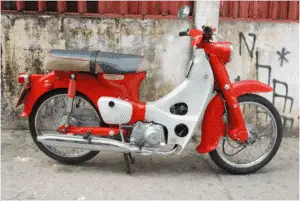
The first Super Cub with overhead camshaft, but the older “coolke Harrie” variant. Had a slightly larger displacement than the C100 with its 65cc, but was otherwise almost the same. Has also been available in several places in the world, but not in the Netherlands. They were sold in America and England.
CT50/CT90/CT110 Trail Cub
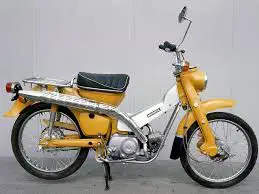
The successors to the former Trail Cubs. Came with 50, 90 and 110cc and a overhead camshaft. Because the CT110 was used by postmen in Australia, it is also called the “postie bike”.
C50 Super Cub (1966)
The C50 was the successor to the C100. The shape remained the same in the base, but it had other indicators and the headlight was now in the HandlebarHouse. The engine was one with overhead camshafts and 50cc. In 1971 it was brought to the Netherlands, now with moped registration. Before that, it had received a set of pedals, a white piece on the rear fender and a ULO taillight. it also had to be limited, this was done by means of a flywheel with abandonment mechanism. In 1974, sales in the Netherlands stopped because it would then have to be homologated again. According to Honda Nederland, this would not have been profitable. Sales continued steadily in other countries and the C50 slowly evolved. it was given a 12v system, different colours and in some versions a square headlight. For the Asian market, the C50 is still being built and it still sells well there.
C70 Super Cub (1970)
Pretty much the same as the C50, but 70cc. This model is extra special, because it is still being built today and has hardly changed from the version presented in 1970. Over it got 12v and some versions electric start.
C90 Super Cub (1970)
The fastest of the old Super Cubs. It’s not going to be built now. Almost identical to the C70, except that there is also a type of the C90 with square headlight.
C50LMX Little Cub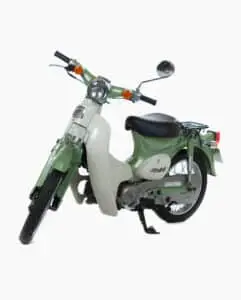
Like a C50, but with smaller wheels. This moped only comes in Japan, now also with fuel injection. There are many special editions of them in all kinds of separate color combinations. Has four gears. Iinmiddelsa has already brought the Fourstrokebarn the necessary little cubs to the Netherlands so take a look around the “barn” and there is definitely something beautiful in front of you at
Wave/Astrea/Dream/Innova etc. – 1990s
Not technically a Super Cub, but it is distracted from it. There are many different variants with different names for different countries, but they all have an engine engine with at least 97cc, four foot gears and a modern look. Most variants also have a scitfrem.
 Honda Gorilla
Honda Gorilla 
